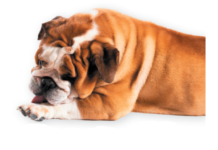[From Tufts June 2010 Issue]
Whether during the drama of a fire or the innocence of a walk, dogs suffer burns just like people do. “In summer, they burn their paw pads by walking across hot asphalt streets or parking lots,” says Scott Shaw, DVM, a specialist in emergency and critical care at Cummings School of Veterinary Medicine at Tufts University. “In winter, they get stuck under radiators in the house, or they go under a car and touch a hot muffler or tailpipe.”
Sometimes, too, people accidentally burn them. “For example, heating pads left next to the skin can cause burns, when all the person tried to do was keep an older dog warm,” Dr. Shaw says. The injury happens slowly, the burn going deeper and deeper. “The same thing happens to elderly people.”
Common type
Burns caused by heat are called thermal burns. They’re the most common type among dogs. Others are electrical, most often from chewing electrical cords; radiation, such as skin injury from cancer treatment and sunburn; and chemical, from walking in or licking caustic substances.
What to do if your dog suffers a thermal burn?
“Rapidly cool the burn area with running tap water but not ice, which can damage the skin,” Dr. Shaw says. Stop when the pain seems to have eased in about 10 to 30 minutes. “The reason to do this is, even when you take away the heat source, it’s still hot in that area of the skin and more damage may be done.”
As in people, heat-caused burns in dogs are classified by their depth:
– First degree: The skin is dry and red, and may be painful, slightly swollen and sensitive to touch. Only the top layer of skin is damaged, and the hair may still be attached. These burns can be healed at home.
– Second degree: Blisters may appear on the dog’s skin, which is red, painful and swollen. The burn reaches to some deeper skin layers and becomes weepy.
– Third degree: All the layers of skin are injured. There is swelling but no pain since the nerve endings which conduct pain signals to the brain have been destroyed. The skin is dry and may resemble leather or may be white or black.
The usual quick touch at a heat source — a first-degree burn — generally doesn’t need veterinary attention, but second- and third-degree burns do. Wrap a minor burn initially with damp gauze, then with a clean, dry bandage. Change the bandage daily or if it gets dirty or wet. Never put ointment, salve, butter or other old-time remedies on the burn, Dr. Shaw says. They increase the risk of infection and don’t promote healing.
Major burns require a veterinarian’s attention. When 20 percent of a dog’s body is burned, he may suffer shock, an emergency in which blood flow drops. A dog with second- or third-degree burns may need intravenous fluids, antibiotics and a hospital stay to recover.
While the actual area where a third-degree burn occurs isn’t painful, it’s usually surrounded by areas with less damage that sustained first- and second-degree burns. That typically requires pain medication, as well as feeding tubes and a higher-calorie diet, surgical removal of dead or infected tissue and skin grafts. Complications may set in, such as kidney failure, anemia, dehydration and sepsis, a serious inflammatory response by the entire body.
The prognosis for first-degree burns is good, but if second-degree burns cover 50 percent or more of the body, or third-degree burns cover 30 percent or more, the dog may die.
The good news: Some burns are preventable — by you. All you need to do is turn down the heating pad. They should be used only on the lowest setting for no more than 20 to 30 minutes at a time. Also, supervise your dog around hazards such as stoves, barbecue grills and sun-roasted pavement.




